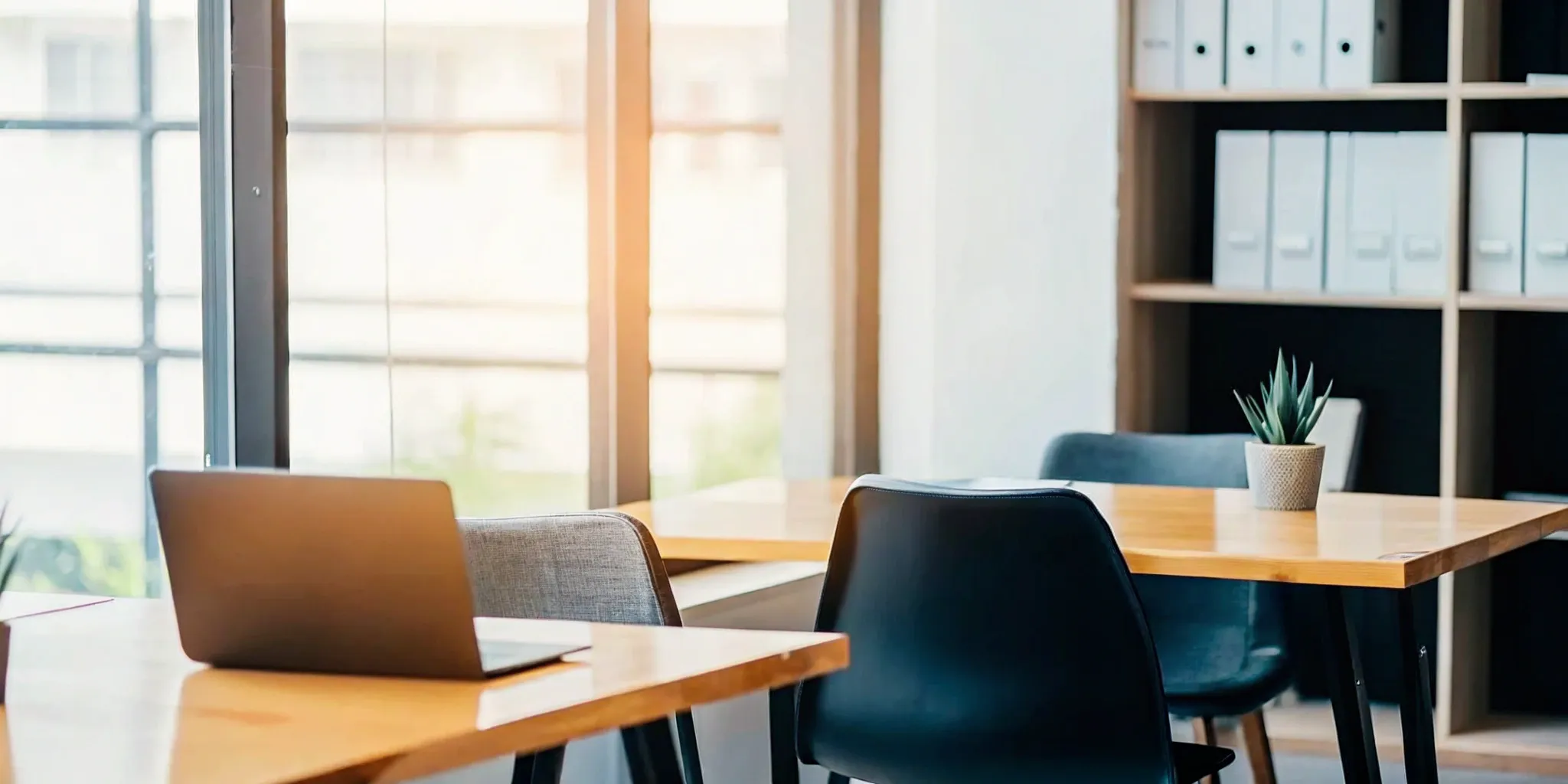In today's fast-paced and ever-changing work environment, it is important for organizations to embrace flexibility in their workplace design to promote maximum efficiency. A rigid and inflexible workplace can hinder productivity and stifle creativity. In this article, we will explore the concept of a flexible workplace and discuss its key features, as well as the importance of flexibility in the modern workplace. We will also provide practical steps to create a flexible workplace design, showcase case studies of successful implementations, and address challenges that may arise during the process.
Understanding the Concept of a Flexible Workplace
Over the years, workplace design has undergone a significant evolution. Gone are the days of cubicles and fixed workstations. A flexible workplace design goes beyond the traditional layout by offering versatility, adaptability, and choice to employees. It aims to create an environment that supports collaboration, innovation, and employee well-being.
The Evolution of Workplace Design
Workplace design has come a long way from the cookie-cutter cubicle farms of the past. Today, organizations are realizing the importance of creating spaces that inspire and engage employees. From open office layouts to activity-based workstations, the focus is on creating an environment that promotes collaboration, creativity, and overall employee satisfaction.
One of the key factors driving the evolution of workplace design is the changing nature of work itself. With the rise of technology and globalization, work is no longer confined to a physical location. Employees can now work from anywhere, thanks to the advancements in remote work and virtual collaboration tools. This shift has led to a reimagining of the traditional office space, with a greater emphasis on flexibility and adaptability.
Another driving force behind the evolution of workplace design is the recognition of the impact that the physical environment has on employee well-being. Research has shown that factors such as natural light, access to nature, and ergonomic furniture can significantly improve employee productivity and satisfaction. As a result, organizations are incorporating these elements into their flexible workplace designs to create a more holistic and supportive environment for their employees.
Key Features of a Flexible Workplace
A flexible workplace design incorporates several key features that contribute to its effectiveness. These include:
- Open and collaborative spaces that encourage interaction and teamwork
- Flexible workstations that can be easily customized to suit individual needs
- Alternative workspaces such as standing desks, quiet rooms, and lounge areas
- Technology-enabled environments that support remote work and virtual collaboration
- Ample natural light and biophilic elements that enhance well-being
Open and collaborative spaces are a hallmark of a flexible workplace design. These spaces are designed to foster communication and collaboration among employees, breaking down the barriers that traditional cubicles create. By creating an environment that encourages interaction and teamwork, organizations can tap into the collective knowledge and creativity of their employees, leading to increased innovation and problem-solving.
Flexible workstations are another key feature of a flexible workplace design. These workstations can be easily adjusted and customized to suit individual needs and preferences. Whether an employee prefers a standing desk, a traditional desk and chair setup, or a more relaxed lounge area, a flexible workstation allows them to choose the setup that best supports their work style and comfort.
In addition to flexible workstations, a flexible workplace design also includes alternative workspaces. These spaces provide employees with options for different types of work or activities. For example, a standing desk area may be available for employees who prefer to work while standing, while quiet rooms can offer a peaceful environment for focused work or private meetings. Lounge areas can provide a more relaxed setting for informal discussions or brainstorming sessions.
Technology plays a crucial role in a flexible workplace design. With the increasing prevalence of remote work and virtual collaboration, organizations need to provide their employees with the tools and infrastructure to work seamlessly from anywhere. Technology-enabled environments, such as video conferencing facilities and cloud-based collaboration platforms, enable employees to connect and collaborate with their colleagues, regardless of their physical location.
Lastly, a flexible workplace design prioritizes the well-being of employees by incorporating elements that promote a healthy and supportive environment. Natural light, for example, has been shown to have numerous benefits, including improved mood, increased productivity, and better sleep quality. By maximizing the use of natural light and incorporating biophilic elements, such as plants and natural materials, organizations can create a workspace that enhances employee well-being and overall satisfaction.
The Importance of Flexibility in the Modern Workplace
Flexibility is no longer just a buzzword in the corporate world; it has become a necessity. The modern workplace is characterized by rapid technological advancements, changing demographics, and evolving workstyles. To thrive in this dynamic landscape, organizations must embrace flexibility.
One of the key benefits of a flexible workplace design is its ability to enhance employee productivity. By giving employees the freedom to choose where and how they work, they feel empowered and motivated. This freedom promotes a sense of ownership and accountability, leading to increased efficiency and output.
Imagine a workplace where employees have the flexibility to work from home, a coffee shop, or a collaborative workspace within the office. This level of flexibility allows employees to tailor their work environment to their preferences and needs. Some employees may thrive in a quiet, focused environment, while others may find inspiration in a bustling, social setting. By providing options, organizations can cater to the diverse workstyles and preferences of their employees, ultimately leading to higher productivity levels.
Furthermore, a flexible workplace design fosters creativity and innovation. In today's fast-paced and competitive business landscape, creativity and innovation are essential for organizations to stay ahead. A rigid and traditional office setup can stifle creativity and hinder the flow of ideas. On the other hand, a flexible workplace design encourages collaboration, brainstorming, and the sharing of ideas.
Imagine a workspace with open, inviting areas where employees can gather to exchange ideas, discuss projects, and challenge each other's thinking. These spaces can be equipped with whiteboards, comfortable seating, and interactive technology to facilitate collaboration and idea generation. By providing spaces that facilitate interaction and creative thinking, organizations can drive innovation and unlock the full potential of their workforce.
Additionally, a flexible workplace design can improve employee well-being and work-life balance. The traditional 9-to-5 work schedule is no longer the norm. With the advancements in technology, employees can now work remotely and have more control over their work hours. This flexibility allows employees to better manage their personal commitments and achieve a healthier work-life balance.
Organizations that prioritize flexibility in the workplace also tend to attract and retain top talent. In today's job market, employees value flexibility and work-life balance as much as salary and benefits. By offering a flexible work environment, organizations can differentiate themselves from competitors and become an employer of choice.
In conclusion, flexibility is not just a trend; it is a crucial element for success in the modern workplace. By embracing flexibility, organizations can enhance employee productivity, foster creativity and innovation, improve employee well-being, and attract top talent. As the business landscape continues to evolve, organizations must adapt and create flexible work environments to thrive in the ever-changing world of work.
Steps to Create a Flexible Workplace Design
Creating a flexible workplace design requires careful planning and consideration. It is a process that involves assessing your current workplace design, identifying your organization's needs, and incorporating flexibility into your design. By following these practical steps, you can create a workspace that promotes productivity, collaboration, and adaptability.
Assessing Your Current Workplace Design
Begin by evaluating your current workplace design. Take a close look at the layout, furniture, and overall functionality of your workspace. Are there any bottlenecks or areas that may hinder flexibility? Consider both physical aspects and intangible factors, such as company culture and employee preferences.
During this assessment, pay attention to the flow of your workspace. Are there areas where employees frequently gather or collaborate? Are there spaces that seem underutilized or isolated? Understanding the current dynamics of your workplace will help you identify areas for improvement.
Identifying Your Organization's Needs
Next, determine what your organization needs in terms of flexibility. Consider factors such as the nature of work, team dynamics, and future growth projections. Engage with employees to gather their input and understand their preferences.
Hold meetings or surveys to gather feedback from your employees. Ask them about their work habits, preferences for collaborative or individual workspaces, and any specific needs they may have. By involving your employees in the decision-making process, you can ensure that the final workplace design meets their needs and fosters a positive work environment.
Incorporating Flexibility into Your Design
With a clear understanding of your organization's needs, start incorporating flexibility into your workplace design. This may involve rearranging workstations, creating multi-functional areas, or implementing hot-desking policies.
Consider implementing modular furniture that can be easily rearranged to accommodate different work styles and team sizes. This will allow your workspace to adapt to changing needs and promote collaboration. Additionally, create designated areas for different types of work, such as quiet zones for focused work and open areas for brainstorming and collaboration.
Another way to incorporate flexibility is by implementing technology solutions that support remote work and virtual collaboration. This can include providing employees with laptops or tablets, video conferencing tools, and cloud-based project management platforms.
Remember to strike a balance between collaborative spaces and areas for individual focus. While collaboration is important, employees also need quiet spaces where they can concentrate and work without distractions.
By following these steps and taking the time to plan and implement a flexible workplace design, you can create a workspace that promotes productivity, employee satisfaction, and adaptability. A flexible workplace design will not only benefit your current employees but also attract and retain top talent in the future.
Case Studies of Successful Flexible Workplace Designs
Let's take a look at some real-world examples of organizations that have successfully implemented flexible workplace designs:
Tech Industry Examples
Companies in the tech industry, such as Google and Microsoft, are known for their innovative workplace designs. They offer a mix of open plan workspaces, relaxation zones, and recreational areas that foster collaboration and inspire creativity.
Non-Tech Industry Examples
Flexible workplace designs are not limited to the tech industry. Companies like Airbnb and Coca-Cola have also embraced flexibility in their workplace design. They have created vibrant environments that cater to the diverse needs of their employees, promoting engagement and well-being.
Overcoming Challenges in Implementing a Flexible Workplace Design
Implementing a flexible workplace design can come with its fair share of challenges. Let's explore some common hurdles you may encounter:
Resistance to Change
Not everyone embraces change with open arms. Some employees may be resistant to the idea of a flexible workplace design, fearing disruption or loss of personal space. It is crucial to communicate the benefits and address concerns to gain buy-in from employees at all levels.
Cost Implications
Introducing flexibility in the workplace may require investments in new furniture, technology, and infrastructure. This can be a challenge for organizations operating within tight budgets. However, the long-term benefits, such as improved employee satisfaction and productivity, far outweigh the initial costs.
In conclusion, creating a flexible workplace design is essential for organizations aiming to maximize efficiency and employee engagement. By understanding the concept, incorporating key features, and addressing challenges, organizations can create an environment that fosters productivity, creativity, and innovation. Embrace flexibility and unlock the full potential of your workforce!













.svg)